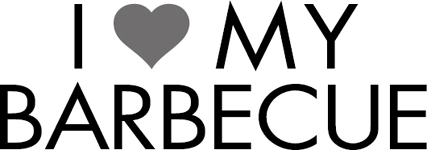

 CONTENTS
CONTENTS  INTRODUCTION The first sign of hot weather makes everyone long to cook over an open fire, so out comes the barbecue. There is no need, though, to restrict your barbecue to summertime use. It can also work well on sunny, still days or in a sheltered spot in spring or autumn, and the recipes in this book will provide you with such a selection of recipes to try that youll want to barbecue as much as possible. It is so much easier now that the available equipment has improved in both quality and range. There is a wider choice of fuels, and there are many accessories which make barbecueing easier and extend the types of dish that can be cooked, from simple, fine-mesh grilling baskets that prevent small pieces of food falling onto the fire, to motorized rotisseries for spit-roasts. Another factor in barbecueings favour is that it is not an exact branch of cooking.
INTRODUCTION The first sign of hot weather makes everyone long to cook over an open fire, so out comes the barbecue. There is no need, though, to restrict your barbecue to summertime use. It can also work well on sunny, still days or in a sheltered spot in spring or autumn, and the recipes in this book will provide you with such a selection of recipes to try that youll want to barbecue as much as possible. It is so much easier now that the available equipment has improved in both quality and range. There is a wider choice of fuels, and there are many accessories which make barbecueing easier and extend the types of dish that can be cooked, from simple, fine-mesh grilling baskets that prevent small pieces of food falling onto the fire, to motorized rotisseries for spit-roasts. Another factor in barbecueings favour is that it is not an exact branch of cooking.
First, the choice and proportions of ingredients in a recipe can be changed to suit your taste, budget or available ingredients. The same applies to flavourings such as herbs and spices. Second, the cooking times can vary due to a number of factors. What you must do, though, is ensure that meat and poultry are adequately cooked, which is why the optimum temperatures have been quoted on pages . It is extremely easy to cook all your barbecued food the way you like it when (as with most things in life) you know how. For example, simply adjusting the height of the grill rack and/or moving the food about on the grill rack can produce far better results.
There are many more useful tips for trouble-free, successful barbecues in this book. Here you will find recipes to suit every occasion, taste and diet. There are simple, traditional dishes, such as Smoky Chicken Wings (see ) will be a hit with children and both vegetarians and vegans will find plenty to satisfy them. If you want to make a special meal using your barbecue, youll find recipes using ingredients such as scallops, king prawns, lobster or guinea fowl. HOW TO COOK ON A BARBECUE There are two main cooking methods used in barbecueing: direct and indirect. Direct is when the food is placed directly above the heat source and is usually turned so that it cooks evenly.
This is suitable for small items that take less than 25 minutes to cook, such as steaks, burgers, chops and vegetables. Indirect is when the foods are covered by the lid of a barbecue, or by aluminium foil, and cook by reflected heat, as in a conventional oven. This method is suitable for large pieces of meat or poultry that require long cooking. COOKING HEATS Cooking can be done over a high, medium or low heat depending on the type of food. The fire is described as hot when the flames have given way to glowing red coals covered with a fine layer of white ash. You should be able to hold your hand 15cm/6in above it for 2 seconds.
This heat is used for cooking thin pieces of food such as fish fillets and chipolata sausages. When the coals are covered by a thicker layer of white ash, the fire has reached the medium heat used for most of the cooking. You should be able to hold your hand over it for 45 seconds. If you can hold your hand over the fire for longer than 5 seconds, it is too cool for cooking, but can be used for keeping cooked food warm. TYPES OF BARBECUE There is such a wide range of types and styles available that it is worth spending a few moments identifying your requirements: how often you will use the barbecue; where you will be barbecueing; the number of people you are likely to cook for most often; how sophisticated you want the equipment to be; and how much money you want to spend on equipment. When it comes to deciding on a barbecue, the main points to consider are the sturdiness of the construction not only of the main part of the barbecue but also any shelves, the spacing of the bars on the grill rack, whether the grill rack has a non-stick coating, the position of any air vents, ease of carrying, if it is portable, and how easy it will be to store.
Gas barbecues: these are easy to use and heat up within about 10 minutes. They can be regulated, giving good control of the cooking, and do not produce ash. However, they dont burn at as high a temperature as charcoal or wood and do not generally give the food the same barbecued taste, although ceramic beads and chippings which can be used on the barbecue, and modifications such as flavouriser bars, can create the authentic aroma and taste. Portable gas barbecues are also available but the grill height is usually static. Hibachi: these cast-iron, trough-like barbecues are heavy but portable. They have short legs and can be used on the ground or on a heat-resistant surface at a comfortable working height.
The distance of the cooking rack from the fire is adjustable. Disposable barbecues: convenient, easy to use and cheap, these barbecues consist of an aluminium foil tray filled with charcoal and a firelighter, covered with a grill. Their limitations are their size, the fact that you cannot adjust the height of the cooking rack or move the food to a cooler part of the grill rack for slightly slower cooking, and a burning time of only about 1 hour. Braziers: these open barbecues vary in size and can have rotisseries for spit-roasting (powered by electricity, battery or hand), wind shields and hoods. They are usually free-standing with wheels or detachable legs, but make sure the legs are long enough otherwise barbecueing can become back-breaking. They should have several air vents, and the height of the grill rack should be adjustable.
Braziers are ideal for single servings of food such as chicken portions, chops, steaks and vegetables. Pedestal barbecues: also known as pillar barbecues, these have a fire bed in an open-topped chimney which is filled with newspaper. Simply light the paper with a taper and it quickly ignites the fuel in the fire bed. Cooking temperature is reached in 2025 minutes. Barrel barbecues: made from cast-iron, these resemble pot-bellied stoves. They are very stable and are used at table height.
They have adjustable grill racks and often a stand for a rotisserie, are easy to light (with newspaper or kindling), and can be ready to cook in just 1015 minutes. Kettle barbecues: these reliable barbecues come in a range of sizes, from table-top models to free-standing versions up to 60cm/24in in diameter. They have a domed metal lid that reflects the heat onto the food, cooking it quickly and evenly and allowing large pieces of meat or whole chickens to be cooked by indirect heat. The cover excludes air, thus reducing flare-ups. Smoke is contained within the barbecue, which heightens the flavour of the food. The cover can be left open for conventional barbecueing by direct heat.
Hooded barbecues: these are sophisticated, usually large, rectangular barbecues set on a moveable trolley, and with a hinged lid. They come with a temperature gauge, dampers to regulate the airflow, moveable grates and cooking grills. Rotisseries, warming racks and side shelves are also available. They work in the same way as a kettle barbecue. Permanent barbecues: choose a sheltered site with easy access to the kitchen but not too near the house. Ordinary house-bricks can be used in the construction, but it is a good idea to line them with firebricks as they withstand the heat better.
Next page
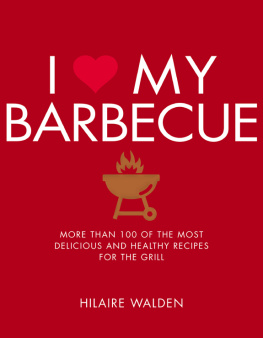

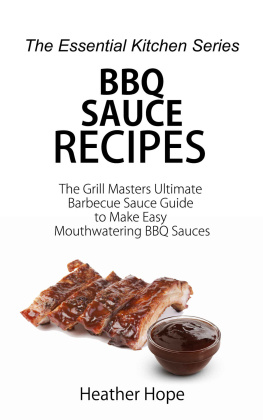

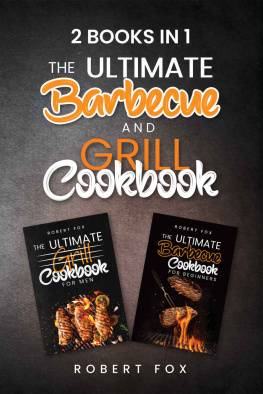
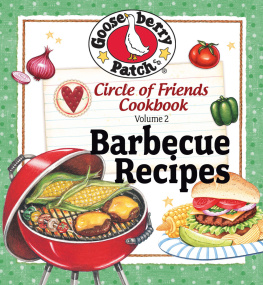
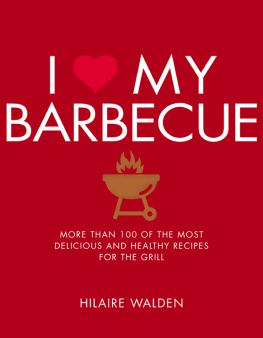
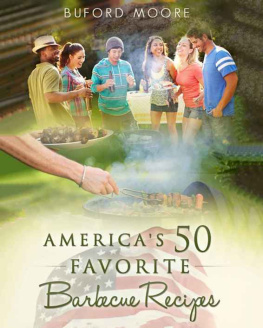
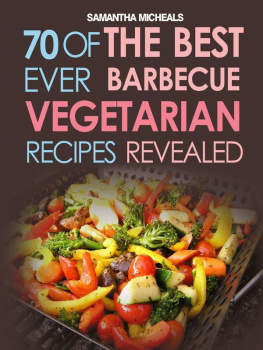


 CONTENTS
CONTENTS  INTRODUCTION The first sign of hot weather makes everyone long to cook over an open fire, so out comes the barbecue. There is no need, though, to restrict your barbecue to summertime use. It can also work well on sunny, still days or in a sheltered spot in spring or autumn, and the recipes in this book will provide you with such a selection of recipes to try that youll want to barbecue as much as possible. It is so much easier now that the available equipment has improved in both quality and range. There is a wider choice of fuels, and there are many accessories which make barbecueing easier and extend the types of dish that can be cooked, from simple, fine-mesh grilling baskets that prevent small pieces of food falling onto the fire, to motorized rotisseries for spit-roasts. Another factor in barbecueings favour is that it is not an exact branch of cooking.
INTRODUCTION The first sign of hot weather makes everyone long to cook over an open fire, so out comes the barbecue. There is no need, though, to restrict your barbecue to summertime use. It can also work well on sunny, still days or in a sheltered spot in spring or autumn, and the recipes in this book will provide you with such a selection of recipes to try that youll want to barbecue as much as possible. It is so much easier now that the available equipment has improved in both quality and range. There is a wider choice of fuels, and there are many accessories which make barbecueing easier and extend the types of dish that can be cooked, from simple, fine-mesh grilling baskets that prevent small pieces of food falling onto the fire, to motorized rotisseries for spit-roasts. Another factor in barbecueings favour is that it is not an exact branch of cooking.